
Long Division Calculator
Calculator Use
Divide two numbers, a dividend and a divisor, and find the answer as a quotient with a remainder. Learn how to solve long division with remainders, or practice your own long division problems and use this calculator to check your answers.
Long division with remainders is one of two methods of doing long division by hand. It is a little easier than solving a division problem by finding a quotient answer with a decimal. If you need to do long division with decimals use our Long Division with Decimals Calculator.
What Are the Parts of Division
For the division sentence 487 ÷ 32 = 15 R 7
- 487 is the dividend
- 32 is the divisor
- 15 is the quotient part of the answer
- 7 is the remainder part of the answer
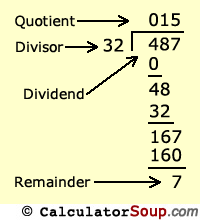
How to do Long Division With Remainders
From the example above let's divide 487 by 32 showing the work.

Put 487, the dividend, on the inside of the bracket. The dividend is the number you're dividing.
Put 32, the divisor, on the outside of the bracket. The divisor is the number you're dividing by.

4 divided by 32 is 0, with a remainder of 4. You can ignore the remainder for now.
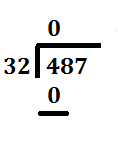
This is the beginning of the quotient answer.
Next, multiply 0 by the divisor 32 and insert the result 0 below the first number of the dividend inside the bracket.
0 * 32 = 0
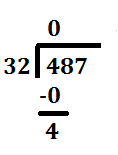
4 - 0 = 4
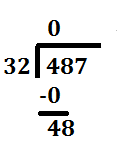
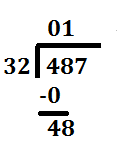
48 ÷ 32 = 1
Note that you could skip all of the previous steps with zeros and jump straight to this step. You just need to realize how many digits in the dividend you need to skip over to get your first non-zero value in the quotient answer. In this case you could divide 32 into 48 straight away.
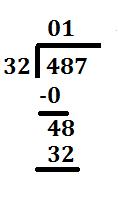
1 * 32 = 32
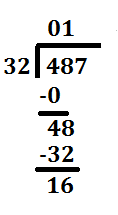
48 - 32 = 16
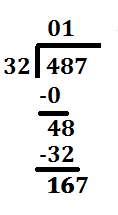
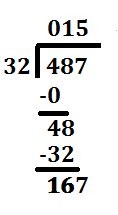
167 ÷ 32 is 5 with a remainder of 7

5 * 32 = 160

167 - 160 = 7

So, 487 ÷ 32 = 15 with a remainder of 7
For longer dividends, you would continue repeating the division and multiplication steps until you bring down every digit from the divdend and solve the long division.